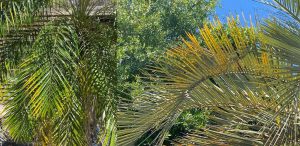Trimming your palms and other tidbits
by David Austin Residential Horticulture Agent Master Gardener Coordinator UF/IFAS Extension, Highlands County, Fl.
Read my other blogs by clicking here.
What about Palms?
Palms are not actually trees. They are monocots and are more closely related to grasses. Some other types of monocots include sedges, orchids, and bamboo. Palms have a single growing point at the top of each stem or trunk known as the apical meristem, commonly called the heart or bud. From this one point, all news leaves or fronds will form. Palms that branch are rare, and often this is caused by damage to the bud that results in it dividing. Only a few species will laterally branch.
The importance of nutrition
Palms require special fertilizers. The University of Florida recommends a slow-release 8-2-12 fertilizer with 4% magnesium. The first three numbers are percentages of nitrogen, phosphorus, and potassium, in that order. Common deficiencies of palms that show up on older fronds are magnesium and potassium. According to the University of Florida, most palms in Florida are seriously deficient in these two nutrients. With potassium, older or lower fronds may have yellowing spots, With Magnesium deficiencies, major yellowing occurs along the tips of the fronds (Figure 1). Palms should be fertilized regularly to stay healthy. Read more here about palm tree fertilization.

Photo to the right: Potassium deficiency is displayed by yellow translucent spots. photo by David Austin
More than just fertilizer
The health of a palm is tied very closely to fertilization but also to how it is trimmed. They rely heavily on making their own food in the form of carbohydrates through the process of photosynthesis. This process requires healthy fronds to remain on the trees. Over-trimming is very detrimental to palms. All fronds that remain mostly green should be left on the palm. Flowers and flower pods can be trimmed off. Taking off too many fronds interferes with the palm being able to produce enough food to sustain it (Figure 2).
Some palms will trim themselves and do not need to be trimmed. These self-cleaning palms have a green crownshaft on the stem below the fronds. They include royal, foxtail, and Christmas palms, to name a few. Most of these species are not cold-hardy and are more commonly found in the warmer climates of South Florida. To learn about trimming palms read more here.

Keep in Touch with UF/IFAS Extension, Highlands County
In Highlands County, our office is at 4509 W George Blvd., Sebring. The Master Gardener Help Desk is open Monday – Friday from 9:30 AM to 3:30 PM.
That’s what’s new from the Hometown Gardener. Like and Follow me on Facebook at Hometown
Read my other blogs by clicking here.
Sign up for our Highlands County Master Gardener Volunteer, “Putting Down Root” Newsletter Here.
Join our Facebook groups Highlands County Master Gardeners, Science-Based Florida Gardening Answers, Central Florida Butterfly and Pollinator Club, and
 0
0
